Fiber Holders and Force Sensors for Multi-Axis Flexure Stages
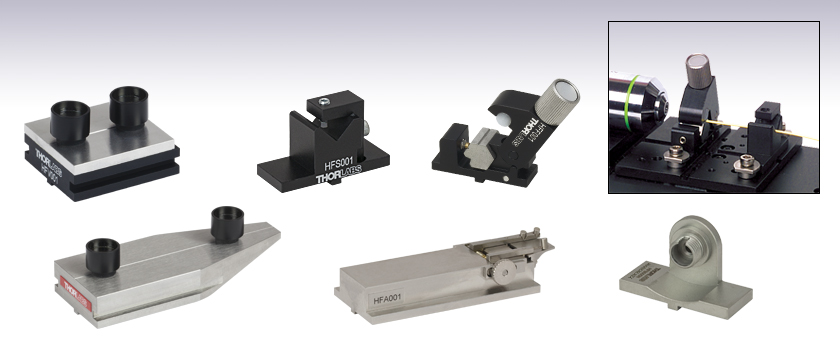
- Adjustable, Magnetic, & Simplified Fiber Clamps
- Fiber Array, Connectorized, & V-Groove Holders
- FC/PC-Connectorized Axial Force Sensor & Cable Strain Relief
Application Idea
HFS001
HFA001
HFF001
HFV001
HFV002
HFB005N

Please Wait
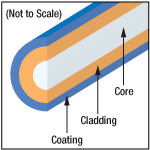
Click to Enlarge
Basic Structure of a Typical Optical Fiber
| Other Bare Fiber Mounts | ||||
|---|---|---|---|---|
| Post Mountable or SM Threaded |
Post Mountable with Vacuum Port |
Flexure Stage Compatible | ||
| V-Mounts | Fiber Block | Clamps | Chucks | Rotators |
This page contains our selection of accessories for multi-axis flexure fiber stages. These include fiber clamps, fiber holders, and axial force sensors. We also offer bare fiber chucks and a rotator for Fiber Launch platforms.
The V-groove fiber holders on this page are typically used to clamp fibers with the coating intact. The diagram to the right shows the structure of a typical fiber, which consists of a core, a cladding, and a coating (note that the diagram is not to scale). The coating serves to protect the cladding of glass fibers from particulates that may land on the surface of the fiber, causing it to become brittle. Although this layer may also have optical properties that allow it to double as a second cladding, it is still referred to as the coating layer due to the protective properties. The term “buffer” is often used instead of “coating” when the layer surrounding the cladding is composed of Tefzel, as this material bonds differently to the glass cladding than other common coating materials such as acrylate or TECS. Some fibers may also have an additional jacket, or buffer applied on top of the coating layer. To determine whether one of the clamps available below is compatible with the fiber used in your application, you must know the diameter of the outer layer (coating, additional jacket, or buffer layer). This value needs to be within the range of specified fiber diameters for the clamp.
Flexure stage mounts can be fixed in position using AMA010(/M) mounting cleats, which are sold below. Each cleat is designed with one edge milled flat, making it possible to insert or remove a flexure stage mount without removing the clamp. Simply loosen the clamp screw and rotate the flat side of the lock-down clamp inward to release the flexure stage mount.
| Multi-Axis Stage Accessories | |||||||||||
|---|---|---|---|---|---|---|---|---|---|---|---|
 |
 |
 |
 |
 |
 |
 |
 |
 |
 |
 |
 |
| Fiber Mounts |
Fiber Rotators |
Waveguide Mounts |
Diode Mounts |
Fixed Mounts |
Kinematic Mounts |
Top Plates |
Extension Platforms |
Fiber Chucks |
Slide Holders |
Kinematic Platforms |
Adapter Plates |
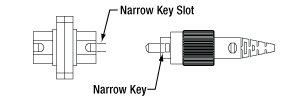
Click to Enlarge
Mating Between a Narrow-Key Mating Sleeve and Connector
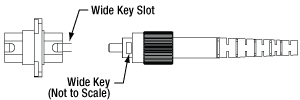
Click to Enlarge
Mating Between a Wide-Key Mating Sleeve and Connector
FC/PC and FC/APC Patch Cable Key Alignment
FC/PC and FC/APC Patch Cables are equipped with either a 2.0 mm narrow or 2.2 mm wide alignment key that fits into a corresponding slot on a mated component. These keys and slots are essential to correctly align the cores of connected fiber patch cables and minimize the insertion loss of the connection.
As an example, Thorlabs designs and manufactures mating sleeves for FC/PC- and FC/APC-terminated patch cables to precise specifications that ensure good alignment when used correctly. To ensure the best alignment, the alignment key on the patch cable is inserted into the corresponding narrow or wide-key slot on the mating sleeve.
Wide-Key-Slot Mating Sleeves
2.2 mm wide-key-slot mating sleeves are compatible with both wide-key and narrow-key connectors. However, using a narrow-key connector in a wide-key slot will allow the connector to rotate slightly in the mating sleeve (as shown in the animation below and to the left). While this configuration is acceptable for patch cables with FC/PC connectors, for FC/APC applications, we recommend using narrow-key-slot mating sleeves to ensure optimum alignment.
Narrow-Key-Slot Mating Sleeves
2.0 mm narrow-key-slot mating sleeves allow for optimal alignment of angled, narrow-key FC/APC connectors, as shown in the animation below and to the right. Therefore, they are not compatible with connectors that have a 2.2 mm wide key. Please note that all FC/PC and FC/APC patch cables manufactured by Thorlabs use narrow key connectors.
Once a narrow key connector is inserted into a narrow-key-slot mating sleeve, the connector will not rotate. We therefore recommend these mating sleeves for FC/PC and FC/APC connectors with narrow keys.
When a narrow key connector is inserted into a wide-key-slot mating sleeve, the connector has room to rotate. For narrow key FC/PC connectors, this is acceptable, but for narrow key FC/APC connectors, significant coupling losses will result.
Insights into Optical Fiber
Scroll down to read about:
- What factors affect the amount of light coupled into a single mode fiber?
- Is the max acceptance angle constant across the core of a multimode fiber?
Click here for more insights into lab practices and equipment.
What factors affect the amount of light coupled into a single mode fiber?
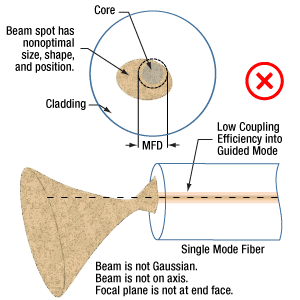
Click to Enlarge
Figure 2 Conditions which can reduce coupling efficiency into single mode fibers include anything that reduces the similarity of the incident beam to the optical properties of the fiber's guided mode.
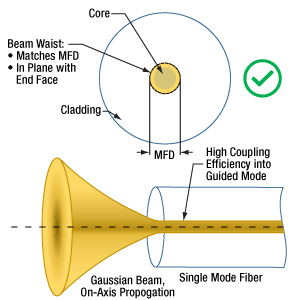
Click to Enlarge
Figure 1 For maximum coupling efficiency into single mode fibers, the light should be an on-axis Gaussian beam with its waist located at the fiber's end face, and the waist diameter should equal the MFD.
Adjusting the incident beam's angle, position, and intensity profile can improve the coupling efficiency of light into a single mode optical fiber. Assuming the fiber's end face is planar and perpendicular to the fiber's long axis, coupling efficiency is optimized for beams meeting the following criteria (Figure 1):
- Gaussian intensity profile.
- Normal incidence on the fiber's end face.
- Beam waist in the plane of the end face.
- Beam waist centered on the fiber's core.
- Diameter of the beam waist equal to the mode field diameter (MFD) of the fiber.
Deviations from these ideal coupling conditions are illustrated in Figure 2.
These beam properties follow from wave optics analysis of a single mode fiber's guided mode (Kowalevicz).
The Light Source can Limit Coupling Efficiency
Lasers emitting only the lowest-order transverse mode provide beams with near-Gaussian profiles, which can be efficiently coupled into single mode fibers.
The coupling efficiency of light from multimode lasers or broadband light sources into the guided mode of a single mode fiber will be poor, even if the light is focused on the core region of the end face. Most of the light from these sources will leak out of the fiber.
The poor coupling efficiency is due to only a fraction of the light in these multimode sources matching the characteristics of the single mode fiber's guided mode. By spatially filtering the light from the source, the amount of light that may be coupled into the fiber's core can be estimated. At best, a single mode fiber will accept only the light in the Gaussian beam output by the filter.
The coupling efficiency of light from a multimode source into a fiber's core can be improved if a multimode fiber is used instead of a single mode fiber.
References
Kowalevicz A and Bucholtz F, "Beam Divergence from an SMF-28 Optical Fiber (NRL/MR/5650--06-8996)." Naval Research Laboratory, 2006.
Date of Last Edit: Jan. 17, 2020
Is the max acceptance angle constant across the core of a multimode fiber?
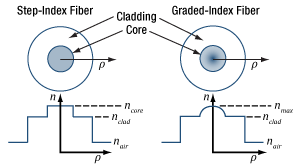
Click to Enlarge
Figure 3: Step-index multimode fibers have an index of refraction ( n ) that is constant across the core. Graded-index multimode fibers have an index that varies across the core. Typically the maximum index occurs at the center.
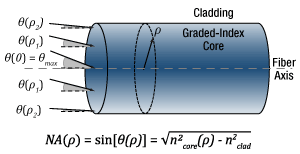
Click to Enlarge
Figure 5: Graded-index multimode fibers have acceptance angles that vary with radius ( ρ ), since the refractive index of the core varies with radius. The largest acceptance angles typically occur near the center, and the smallest, which approach 0°, occur near the boundary with the cladding
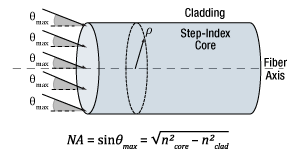
Click to Enlarge
Figure 4: Step-index multimode fibers accept light incident in the core at angles ≤|θmax | with good coupling efficiency. The maximum acceptance angle is constant across the core's radius ( ρ ). Air is assumed to surround the fiber.
It depends on the type of fiber. A step-index multimode fiber provides the same maximum acceptance angle at every position across the fiber's core. Graded-index multimode fibers, in contrast, accept rays with the largest range of incident angles only at the core's center. The maximum acceptance angle decreases with distance from the center and approaches 0° near the interface with the cladding.
Step-Index Multimode Fiber
The core of a step-index multimode fiber has a flat-top index profile, which is illustrated on the left side of Figure 3. When light is coupled into the planar end face of the fiber, the maximum acceptance angle (θmax ) is the same at every location across the core (Figure 4). This is due to the constant value of refractive index across the core, since the acceptance angle depends strongly on the index of the cladding.
Regardless of whether rays are incident near the center or edge of the core, step-index multimode fibers will accept cones of rays spanning angles ±θmax with respect to the fiber's axis.
Graded-Index Multimode Fibers
The core of a typical graded-index multimode fiber, shown on the right side of Figure 3, has a refractive index that is greatest at the center of the core and decreases with radial distance ( ρ ). The equation included below the diagram in Figure 5 shows that the radial dependence of the core's refractive index results in a radial dependence of the maximum acceptance angle and numerical aperture (NA). This equation also assumes a planar end face, normal to the fiber's axis that is surrounded by air.
Cones of rays with angular ranges limited by the core's refractive index profile are illustrated Figure 5. The cone of rays with the largest angular spread
Step-Index or Graded Index?
A step-index multimode fiber has the potential to collect more light than a graded-index multimode fiber. This is due to the NA being constant across the step-index core, while the NA decreases with radial distance across the graded-index core.
However, the graded-index profile causes all of the guided modes to have similar propagation velocities, which reduces the modal dispersion of the light beam as it travels in the fiber.
For applications that rely on coupling as much light as possible into the multimode fiber and are less sensitive to modal dispersion, a step-index multimode fiber may be the better choice. If the reverse is true, a graded-index multimode fiber should be considered.
References
Keiser G, "Section 2.6." Optical Fiber Communications. McGraw-Hill, 1991.
Date of Last Edit: Jan. 2, 2019
| Posted Comments: | |
Nolan Wright
(posted 2024-09-03 12:56:44.63) when I try to download the step file and open it in Creo the model is blank spolineni
(posted 2024-09-09 05:16:22.0) Thank you for your feedback. I will contact you directly to provide the step file and assist you further. user
(posted 2024-08-16 09:14:16.283) what is the tolerance for the angle on the keyway on the "Connectorized-Fiber Holders" ie. 90deg +/- what? jdelia
(posted 2024-08-20 03:41:16.0) Thank you for contacting Thorlabs. I have contacted you directly to clarify and provide the tolerance you are seeking. Mark Denninger
(posted 2023-09-01 10:57:57.9) Deat Thorlabs
I was wondering what the ID and tolerance is on the SMA entry hole on the part HFB001B. The drawing states 3.2 mm but I believe this number is a rounded value from the real value? Could you elaborate on the ID and tolerance with a more precise indication?
Kind regards
Mark Denninger
Optheras A/S jdelia
(posted 2023-09-06 01:26:03.0) Thank you for contacting Thorlabs. I have reached out to you directly regarding the dimensional tolerancing for the inner diameter you called out. Igor Perchuk
(posted 2023-03-22 09:38:23.853) Is there a way to replace the nylon pad after heavy use and wear? Maybe there is another model similar that allows routine changes for the nylon pad. JReeder
(posted 2023-03-24 05:25:38.0) Thanks for your enquiry. Unfortunately the Nylon clamp in the HFF001 is not replaceable as it is glued in. I will post this on our internal engineering forum as a request. One alternative we have that provides replacement holders is the HFV001 with the replacement magnetic clamps HFM001. user
(posted 2022-05-04 18:27:57.01) Hi, I'm wondering if it's possible to make a version of HFV002 that accepts 125 um (stripped) fibers instead of the current minimum diameter of 150 um.
It would be nice to have a version that works with fully stripped fibers. DJayasuriya
(posted 2022-05-06 09:08:41.0) Thank you for your feedback. We do have HFF001 which would work with the 125µm. Would this work with you application. If you do have any questions our tech support team will be happy to help. Robert Standaert
(posted 2021-02-08 20:11:44.92) Hello,
I am very interested in this product. Could you please let me know what materials the grooved hex ferrule and white plastic pressure bar in the swing arm are made from?
Thanks,
Bob cwright
(posted 2021-02-10 05:56:48.0) Response from Charles at Thorlabs: Thank you for your query. The grooved fibre holder insert is made from 316 stainless steel and the clamp roller is made from white Nylon 66. Anthony Artuso
(posted 2020-12-10 10:25:50.677) is there any interest in an HFB004 fiber holder where the ferrule extends (1mm) beyond the surface of the fixture? DJayasuriya
(posted 2020-12-16 03:53:58.0) Thank you for your inquiry. Unfortunately we haven't had any request for this, but I will get in touch with you directly to discuss your application. user
(posted 2020-02-21 03:50:22.213) HFB004 et HFB005 use wide key slot while your fiber patch cables use narrow key. A narrow key version of these would make sense. DJayasuriya
(posted 2020-02-21 10:04:21.0) Response from Thorlabs: Thank you for your feedback. I will pass this on to our engineering team. Alexander Dudgeon
(posted 2019-11-06 06:09:47.42) What is the HFV002 supposed to slide into? I cant seem to find a top plate for a stage/optical bench etc DJayasuriya
(posted 2019-11-22 04:27:30.0) Response from Dinuka at Thorlabs: Thank you for your question. These accessories are for multi-axis flexture stages. e.g. you would be able to use the HFV002 with a MMP1 top plate which is generally included with our 3 axis stages. If you like to discuss your application further please contact your local tech support office. user
(posted 2019-05-16 09:40:29.883) Is it possible to get one of your force sensor products with with flex cabling? We have an application where the force sensor itself will be mounted on a stage with significant range and we are worried about cable wear and breaks. AManickavasagam
(posted 2019-05-28 10:18:26.0) Response from Arunthathi at Thorlabs: Thanks for your query. Unfortunately, we do not normally change the standard cable that comes with the force sensor. For most usage there has not been any issue with the standard cable wearing out or being broken. We will contact you directly to discuss your application further. user
(posted 2019-02-22 23:30:47.53) Can FSC102 be uaed vertically (to detect bare fiber contact with the table). ? bhallewell
(posted 2019-02-26 03:44:59.0) Response from Ben at Thorlabs: Thank you for your question. The FSC102 & FSC103 options are only intended for horizontal (axial) force sensing. ps2c11
(posted 2017-06-01 15:42:53.617) Dear Dir/Madam,
I was wondering if you could tell me which steel HFV002 is made from?
All the best,
Peter bwood
(posted 2017-06-01 11:22:45.0) Response from Ben at Thorlabs: Thank you for your feedback. The main body of the HFV002 is made from 410 stainless steel. The clamp also contains Sorbothane, Delrin and NiCuNi-coated Neodymium components. sebastien.loranger
(posted 2015-10-21 12:22:28.17) Little proposition for fiber holder:
For high power injection (>1 W), a glass holder is required to avoid light absorption around the fiber and to match heat expansion coefficient. It would be useful if you had a glass plate mounted on metal base compatible with multi-axis stage. The glass plate would have a groove to hold the fiber. The glass plate would have to be fixed on the metal to allow a minimum different thermal expansion, while remaining as rigid as possible to avoid disalignement when power is increased.
Hope you'll consider this idea!
Sébastien Loranger rcapehorn
(posted 2015-10-27 07:20:47.0) Response from Rob at Thorlabs: Thank you very much for your feedback and new product idea. I will submit this to our engineers and keep you updated if the idea goes into development. As always we appreciate any feedback from our customers and encourage all suggestions you may have for us. |

- Holders for Connectorized Fibers:
- HFB001B: SMA
- HFB004W: FC/PC, Wide Key Slot (2.2 mm)
- HFB004N: FC/PC, Narrow Key Slot (2.0 mm)
- HFB005W: FC/APC, Wide Key Slot (2.2 mm)
- HFB005N: FC/APC, Narrow Key Slot (2.0 mm)
- 12.5 mm Optical Axis Height
These connectorized-fiber holders are compatible with the mounting platforms of our multi-axis flexure stages. Each holder is designed to securely hold the center of the connector 12.5 mm (0.49") above the flexure stage platform. The design virtually eliminates fiber tip motion when the fiber cable is moved and significantly improves the repeatability of the positioning of the fiber tip. Our holders for FC/PC- and FC/APC-connectorized fibers are available with either wide key (2.2 mm) or narrow key (2.0 mm) slots. Please see the Key Alignment tab for more information.

- Multi-Purpose V-Groove Insert Features 5 Different V-Grooves and 1 Flat Surface
- Accommodates Fibers or Cylindrical Optical Elements with Diameters from 125 µm to 2.66 mm
- Fiber Clamping Arm with Adjustable Knob Provides 0.25 - 2.0 N (0.06 - 0.45 lb) of Holding Force
This quick-release, adjustable-force fiber clamp has many features that make it our most versatile fiber clamp. The top knob is used to adjust the force that the clamping arm exerts on the fiber. This feature is useful when working with specialty fibers, such as highly birefringent fibers, photonic crystal fibers, or exotic glass fibers containing fluoride or tellurite.
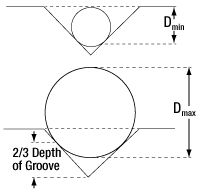
| Accepted Diametersa | ||
|---|---|---|
| Hexagon Flat | Dmin | Dmax |
| 1 | 0.125 mm | 0.240 mm |
| 2 | 0.147 mm | 0.333 mm |
| 3 | 0.3 mm | 0.666 mm |
| 4 | 0.6 mm | 1.333 mm |
| 5 | 1.2 mm | 2.66 mm |
The fiber holder features a grooved central ferrule with six mounting surfaces, which together accept fibers or other cylindrical objects that have an outer diameter between 125 µm to 2.66 mm. Simply rotate the ferrule to align the correct mounting groove with the clamping arm and secure with the included M4 setscrew. It has been designed to allow rapid mounting and dismounting of a variety of photonic components, including bare optical fibers, optical fibers mounted in ceramic ferrules, and multi-channel waveguides.
To determine whether this clamp is suitable for your application, you must know the diameter of the cylindrical object that you wish to secure in the clamp, such as the outer layer (coating or additional jacket or buffer layer) of your fiber or the size of your ferrule. The table to the right specifies the minimum and maximum diameters a cylindrical object can have in order to be securely held by each groove in the HFF001.
For a simpler clamp for coated fiber, please consider the HFF003 Quick-Release Fiber Clamp listed below.


| Accepted Diametersa | |
|---|---|
| Dmin | Dmax |
| 150 µm | 341 µm |
- Precision V-Groove Designed to Hold Ø150 µm to Ø341 µm Fibers
- Stainless Steel Construction Provides Robust, Wear-Resistant Surface
- HFM001 Magnetic Clamps Feature a Soft Elastomer Pad to Protect Fiber Cladding from Damage
For ease of mounting and experimental flexibility, the HFV001 Standard V-Groove Fiber Holder is an ideal solution for securing bare (coating intact), single mode fibers. The fiber is held in the precision V-groove by two magnetic clamps. The clamps have a special elastomer pad that locally distorts around the fiber to provide a secure but delicate grip. The base of the holder is made of anodized aluminum, and the top plate is made of magnetic stainless steel.
For a longer holder optimized for fiber coupling to smaller devices, please consider the HFV002 Tapered V-Groove Fiber Holder sold below. The HFM001 Magnetic Clamps are also available separately below.


| Accepted Diametersa | |
|---|---|
| Dmin | Dmax |
| 150 µm | 341 µm |
- Precision V-Groove Designed for Ø150 µm to Ø341 µm Fibers
- Stainless Steel Construction Provides Robust, Wear-Resistant Surface
- Tapered End Maximizes Access to Fiber in Industrial Coupling Applications
The HFV002 Tapered V-Groove Fiber Holder, which is longer than our HFV001 Fiber Holder sold above, is designed to allow access to smaller devices. When butt-coupling fibers to small waveguide devices (particularly when the device is mounted on a waveguide manipulator), it is often difficult to support and position the end of the fibers close enough to the input ports of the waveguide with standard V-groove holders. The tapered top plate of this mount improves the user's ability to visually observe the fiber-waveguide interface.
The fiber is secured with the two provided HFM001 Magnetic Clamps. These clamps are also available separately below.


| Accepted Diametersa | |
|---|---|
| Dmin | Dmax |
| 150 µm | 341 µm |
- Precision V-Groove Designed to Hold Ø150 µm to Ø341 µm Fibers
- Magnet Holds Clamping Arm in Place
- Simplified Mechanical Design
This fiber clamp is intended for applications that do not require the extra features offered by the HFF001 Fast-Release Fiber Clamp listed above. The clamping arm is designed to swing approximately 120° from the clamping surface to allow easy loading of the fiber into the V-groove. A rare earth magnet is used to hold the clamping arm in place once it is lowered onto the fiber. A M4 (1.5 mm hex) magnetic setscrew is also embedded in the arm to provide a simple means of adjusting the clamping force.


| Accepted Diametersa | |
|---|---|
| Dmin | Dmax |
| 0.663 mm | 5.93 mm |
- Secures 900 µm or 3 mm Diameter Cables
- Mounts Directly on the Deck of Our Popular Multi-Axis Stages
- Prevents Accidental Misalignment
This strain relief accessory ensures that disturbances to the fiber cable are not translated into unwanted movement of the fiber end face, saving time while setting up and running experiments. It is especially useful for large-diameter fibers. A M2.5
(2 mm hex) setscrew allows for vertical adjustment of the clamping arm, and a M2
(1.6 mm hex) clamp setscrew secures the cable in the clamp's V-groove.
To determine whether this clamp is suitable for your application, the diameter of the outer layer (coating or additional jacket or buffer layer) of the fiber must be known. The table above specifies the minimum and maximum diameters that can be held securely. For an brief summary of fiber terminology, please see the Overview tab above.

- Soft Elastomer on Bottom Surface Protects Exposed Fiber Cladding
- Sold in Packages of Six
These magnet assemblies are used to securely hold fibers to our V-groove style fiber holders. Please note that two of these fiber clamps are included with each V-groove style fiber holder. We offer these magnetic clamps as replacement parts. They are also useful for customers building customized fiber optic assemblies.

- Accepts Rectangular Fiber Arrays up to 12 mm Wide
- Actuator Knob Controls Clamping Mechanism and Allows Easy Loading
- Angled Contact Pads Ensure that the Optical Element Sits Flat on the Support Surface
- Also Useful for Mounting Rectangular Optics
The HFA001 Fiber Array Holder uses a single actuator knob to simultaneously move both sides of the clamping mechanism. This two-sided mechanism ensures the device being mounted is centered on the support surface. Three angled clamping surfaces provide a slight downward pressure and stable, three-point contact. The third clamping point is located at the end of a spring-loaded flexure rod that allows the holder to adapt to differently sized optical elements.

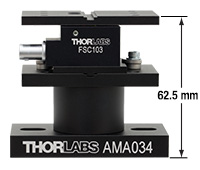 Click To Enlarge
Click To EnlargeThe FSC103 secured onto the AMA034 has the same deck height as our
3-axis platforms.
- Load Capacity: 30 N (6.7 lb)
- Sensitivity: 0.03 N (0.0067 lb)
- 62.5 mm Deck Height with AMA034 Support Post
- 112.5 mm Deck Height with AMA035 Support Post
The FSC103 Axial Force Sensor is a force-sensing cell that can be used to position an optical fiber with respect to another device in the direction of the optical axis. When the fiber makes contact with the device, a force arises that is detected by a strain gauge. This generates an electrical signal that is available for the actuator controller to indicate that the desired position has been reached.
These cells mount in the groove of our AMA034 and AMA035 Post Assemblies. The AMA034 delivers a deck height of 62.5 mm (optical height of 75 mm), which is the same as our 3-axis NanoMax, RollerBlock, and MicroBlock platforms. The AMA035 delivers a 112.5 mm deck height (optical height of 125 mm), which matches our NanoMax 600 6-axis stages.
The FSC103 sensor is compatible with the other flexure stage accessories sold on this page. The KPC101 K-Cube™ Piezo Controller and Strain Gauge Reader is ideal for monitoring the output of the stage's sensor. A PAA622 cable is included with the force sensor for connection to the strain gauge reader.

| Compatible Controllers |
|---|
| KPC101 K-Cube™ Piezo Controller and Strain Gauge Reader BPC301 1-Channel Benchtop Piezo Controller BPC301 3-Channel Benchtop Piezo Controller |
- Load Capacity: 30 N (6.7 lb)
- Sensitivity: 0.03 N (0.0067 lb)
- Two Magnetic HFM001 Fiber Clamps Included
This force-sensing cell uses the same principle as the FSC103 Axial Force Sensor sold above, but is used to position a bare optical fiber with respect to another device. When the fiber makes contact with the device, a force arises that is detected by a strain gauge. This generates an electrical signal that is available for the actuator controller to indicate that the desired position has been reached.
The fiber is secured with the two provided HFM001 Magnetic Clamps. These clamps are also available separately above.

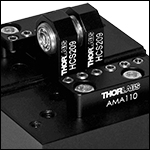
Click for Details
Accessories mounted in close proximity using the AMA110 Mounting Block.
- Secures Components to NanoMax, MicroBlock, or RollerBlock Stages
- Cleats for Mounting Single Components
- Mounting Blocks and Clamps for Close Proximity Mounting of Multiple Components
The AMA010(/M) Cleats have a flat milled along one side. To lock an accessory along the center alignment groove, rotate the cleat so that the flat is facing the groove. Place the accessory into the groove between the cleats, rotate the cleat so that the rounded edge covers the edge of the mount, and lock down the 6-32 (M3) locking screw and washer. The cleats can be rotated without needing to remove the locking screws. See the animation to the right for details. The included screws are 5/16" (8 mm) long and are used with a 3/32" (2.5 mm) hex key.
For mounting multiple components in close proximity, we offer the AMA110 mounting blocks. These mounting blocks feature a line of nylon-tipped setscrews to secure components, and allow for easy repositioning and very close mounting. The blocks are secured via two holes and are supplied with either 6-32 or M3 cap screws.
The AMA111 Narrow Device Mounting Clamps offer an alternative solution when devices need to be mounted close together. They are secured using an M3.5 or M3 washer and a 6-32 or M3 cap screw, compatible with a 7/64" or 2.5 mm hex key, respectively.
 Products Home
Products Home











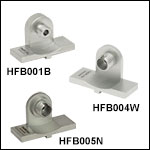
 Zoom
Zoom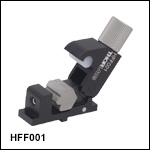
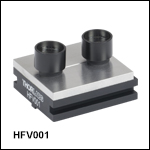
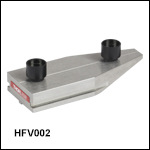
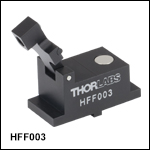
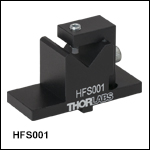
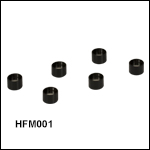
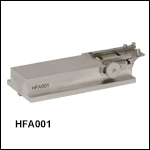
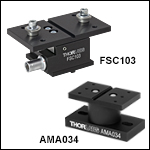
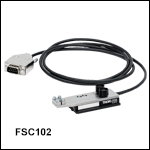
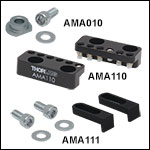
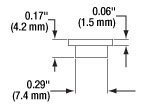


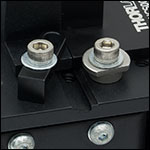
 Bare and Terminated Fiber Holders
Bare and Terminated Fiber Holders